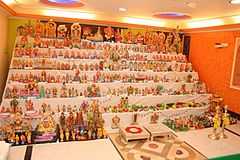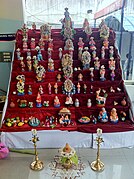Bommala Koluvu
| Bommai Kolu | |
|---|---|
 Display of Kolu in Tamil Nadu | |
| Also called | Navaratri Kolu |
| Observed by | Kannadigas, Telugus and Tamilians |
| Type | Hindu |
| Celebrations | Dasara |
| Begins | Mahalaya |
| Ends | Vijayadasmi |
| Related to | Navratri |
Bommai Kolu (Tamil பொம்மை கொலு ), Bombe Habba (Kannada ಬೊಂಬೆ ಹಬ್ಬ ), Bommala Koluvu (Telugu బొమ్మల కొలువు ), Bomma Gullu (Malayalam ബൊമ്മ ഗുല്ലു) is a doll and figurine display festival celebrated during the festival of Navratri in Southern India, it is customary in the states of Tamil Nadu, Karnataka, Andhra Pradesh and Kerala, as well as in some Tamil communities within Sri Lanka.[1]
Etymology
Bommai Kolu in (Tamilபொம்மை கொலு ) means Divine Presence. Bommala Koluvu in (Telugu బొమ్మల కొలువు ) means Court of Toys and Bombe Habba in (Kannada ಬೊಂಬೆ ಹಬ್ಬ ) means Doll Festival. is part of Dasara festival where young girls and women display dolls, figurine, court life, everyday scenes along with the divine presence of the Goddesses Saraswati, Parvati and Laxmi in the Tamil, Kannada and Telugu households during Navaratri or The Nine nights.
Customs
On the first day of Navaratri odd numbered Kolu or Padi (usually 3, 5, 7, 9, or 11) are set up using wooden planks. After Kolu has been covered with fabric it is then adorned with various dolls, figurines and toys according to their size with deity's at the top. Kolu or Padi is predominantly displayed with depictions from Puranas, court life, royal procession, ratha yatra, weddings, everyday scenes, toys, miniature kitchen utensils, anything a little girl would have used to play with. Most of the wooden toys displayed come from traditional toy makers in Etikoppaka, Kondapalli, Kinnal and Channapatna. It is a traditional practice to have figurine of wooden Bride and Groom together called 'Marapacchi Bommai' or 'Pattada Gombe', they are usually made of Teak or Sandalwood and decorated with new clothes each year before being displayed on Kolu. In ancient times these dolls were representative of local King and Queen, people prayed for their long life and prosperity of the Kingdom.
In the evening women in neighborhood invite each other to visit their homes to view Kolu displays, they exchange gifts and sweets. Kuthuvilakku lamp is lit, in the middle of a decorated Rangoli, devotional hymns and shlokas are chanted. After performing the puja, the food items that have been prepared are offered to the Goddess and then to the guests.
On the 9th day Saraswati Puja, special pujas are offered to Goddess Saraswati, the divine source of wisdom and enlightenment. Books and musical instruments are placed in the puja and worshipped as a source of knowledge.
The 10th day, Vijayadasami – is the most auspicious day of all. It was the day on which evil was finally destroyed by good. It marks a new and prosperous beginning. New ventures started on this day are believed to flourish and bring prosperity. Kids often start tutoring on this day to have a head start in their education.
In the evening of "Vijayadasami", any one doll from the "Kolu" is symbolically put to sleep and the Kalasa is moved a bit towards North to mark the end of that year's Navaratri Kolu. Prayers are offered to thank God for the successful completion of that year's Kolu and with a hope of a successful one the next year. Then the Kolu is dismantled and packed up for the next year.
Significance
Kolu also has a significant connection with agricultural economy of ancient India. It is said that in order to encourage dredging and de-silting of irrigation canals and riverbeds the Kolu celebration was aimed at providing demand for the clay material from such activities. There are many customs and beliefs in different parts of India that imbue sacred status to clay. Dissolving Ganesha dolls made of wet clay into the water system is one such belief. Another example is the Bengali tradition of using clay that has been tread upon by the most beautiful girl in the area to sculpt the face of the Goddess Durga, the belief being that this would be the best way to approximate the perfect features of the Goddess.
Gallery
| Wikimedia Commons has media related to Golu. |
-

Display of the Navratri Golu in seven steps in Tamil Nadu
-
Navratri Golu in Tamil Nadu
-

Navatri Golu
See also
- Hinamatsuri in Japan
References
http://lnp.co.in/news/kolu-celeberation-2014/
External links
- Symbolism of Kolu - http://uni5.co/index.php/en/vedic-festivals/golu.html
